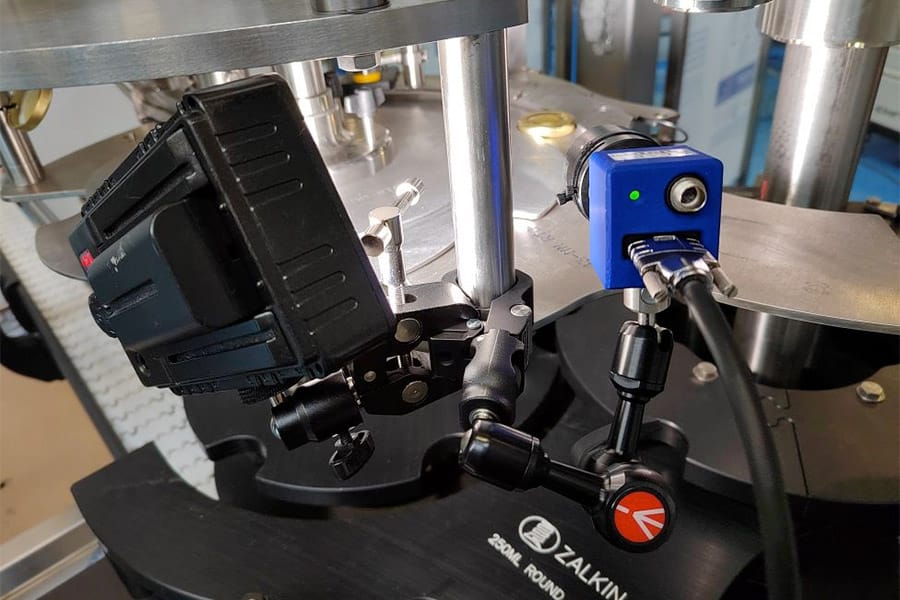High speed cameras record images at extremely fast speeds. They are often used in production lines in large pharmaceutical, food and manufacturing industries. They are high performance, practical, easy to use cameras that improve the efficiency and profitability of a production line in no time! Read on for explanations!
What are High speed cameras used for? What are the benefits?
A High speed cameras is your closest ally for your company and your assembly line.
High speed cameras are useful for spotting a malfunction, a defect on a production line. They enable you to identify the source of a technical issue immediately and fix it quickly. It provides support for technical maintenance staff.
The Trouble Pad camera is an important ally in the pharmaceutical industry in particular. It enables monitoring of an entire production of vaccines, drugs, vials, … manufactured by High speed machines, thus ensuring better productivity. Also, from a safety aspect, the camera can be used to ensure that the parts are properly assembled. Everything is monitored and seen by the camera: every incident is recorded.
Capable of capturing thousands of images every second, it records the production line and enables slow-motion viewing of production operations. It can then be used to capture specific images for detailed analysis of the malfunction. It therefore helps to determine the technical problem on an entire production line, without the need for human interaction.
The speed of the production machines is so fast that an anomaly is not (always) visible to the naked eye. This is where the High speed camera comes into play, establishing itself in its class and acting as an extreme controller. Even the slightest movement is analysed using the camera’s images and this is incredibly useful for correcting the malfunction. The problem can be solved in record time.
Having identified the nature and location of the technical fault via the camera, maintenance staff know exactly how and where to intervene, and can correct it in record time.
Benefits:
- proven time savings,
- maintained production capacity
- guaranteed performance,
- and optimal profitability.
The Trouble Pad high speed camera is the perfect equipment for meeting these objectives and will quickly become an integral part of daily operations for the company and its production lines!
How do High speed cameras perform?
At Clara Vision, we provide a unique, high-end model of High speed camera, the Trouble Pad. It is a complete camera unit, with a touch screen tablet and case.
The High speed camera has a number of high-quality features.
1 Video recording
The images are recorded on a 256 GB (or optional 512 GB / 1 TB) hard disk. The camera’s video software records the footage, providing image capture from 225 to 2500 frames/second.
You won’t miss a single defect! The camera can also make loop recordings, with an adjustable duration set by the operator. The user can also select a section of the footage and keep only the part of the recording that is of real interest. Everything is controlled either manually or automatically with the help of a ‘trigger’.
2 Camera speed
The camera’s speed can be adjusted. The recommended speed is 570 frames per second with a resolution of 800×600 pixels. The standard speed is usually 225 fps with 1280*1024 resolution. Other speeds are possible: 835 fps at 640*480 resolution; 1500 fps at 500*300 resolution; 2500 fps at 320*240 resolution.
3 Playback and slow motion
It is possible to replay and slow down the images captured by the High speed camera. This is a key performance feature ‘on the job’ and one that quickly proves indispensable. The sequences filmed by the camera are automatically recorded on the hard disk, but they can also be (re)viewed after recording to facilitate analysis. In addition, playback speed is fully adjustable. It is therefore possible to isolate parts of a recording, keep the sequence where the malfunction occurs and remove the rest for greater precision and to free up recording space.
4 Lighting
An optimal lighting system is provided with the High speed camera. It lights the area where the camera is filming and can fit into even the tightest and poorly lit areas. Ideal for precision mechanics, its 600-lux output (= 600 lumens per square metre) makes the camera a very effective surveillance accessory. As a comparison, the light is much more powerful than a kitchen spotlight, a streetlamp, a living room light or an office light (around 500 lux). An optional more powerful light (12,000 lumens) is also available.
5 The trigger
The High speed camera can be controlled using a trigger mechanism. It quickly becomes indispensable for monitoring your production line. It will enable you to start and stop a recording at any time, to flag important images and to keep only what is essential. “What is essential” includes the “before” and “after” of the technical incident. The aim: to retain footage of the malfunction. It is this footage that will enable the problem to be solved more quickly.
6 The Touch Tablet
The 12-inch touchscreen tablet makes an important contribution to the High speed camera’s performance. It contains software that enables real-time monitoring of production line footage. Along with the trigger mechanism, the tablet provides the camera with a unique, high-performance monitoring system for error detection. To prevent accidents, the tablet comes with a protective case and a shoulder strap.
Easy to install, practical to use
The High speed camera is surprisingly easy to set up and, above all, quickly operational. The user interface is also simple. Our installation video shows how to install the Trouble Pad high speed camera.
In addition, to complete the package, the case with the camera, the tablet and its software, options are available to make the system even more powerful than it already is. There are more precise lenses, a battery for the lighting, a stand, a trolley on wheels, fixings…





Be first to comment !